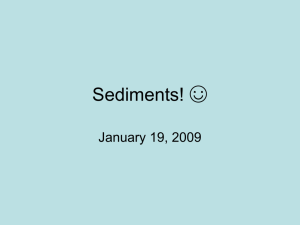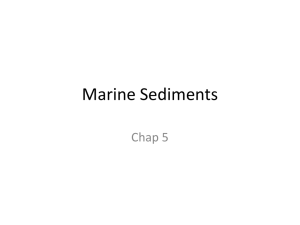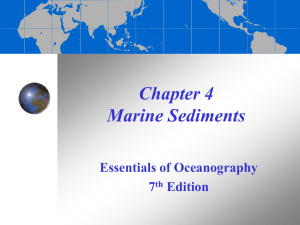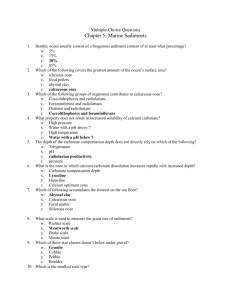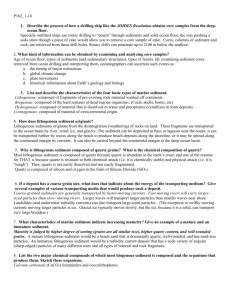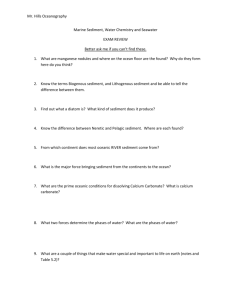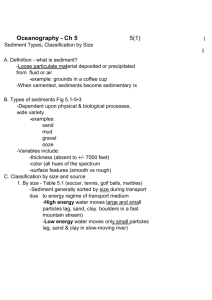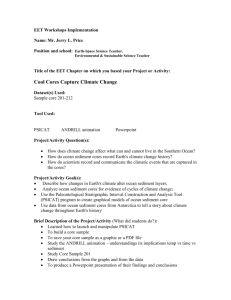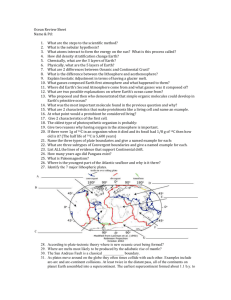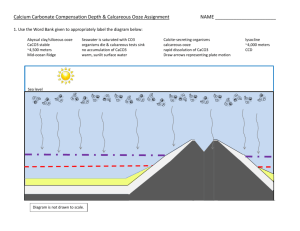Marine Sediments: Oceanography Lecture Notes
advertisement
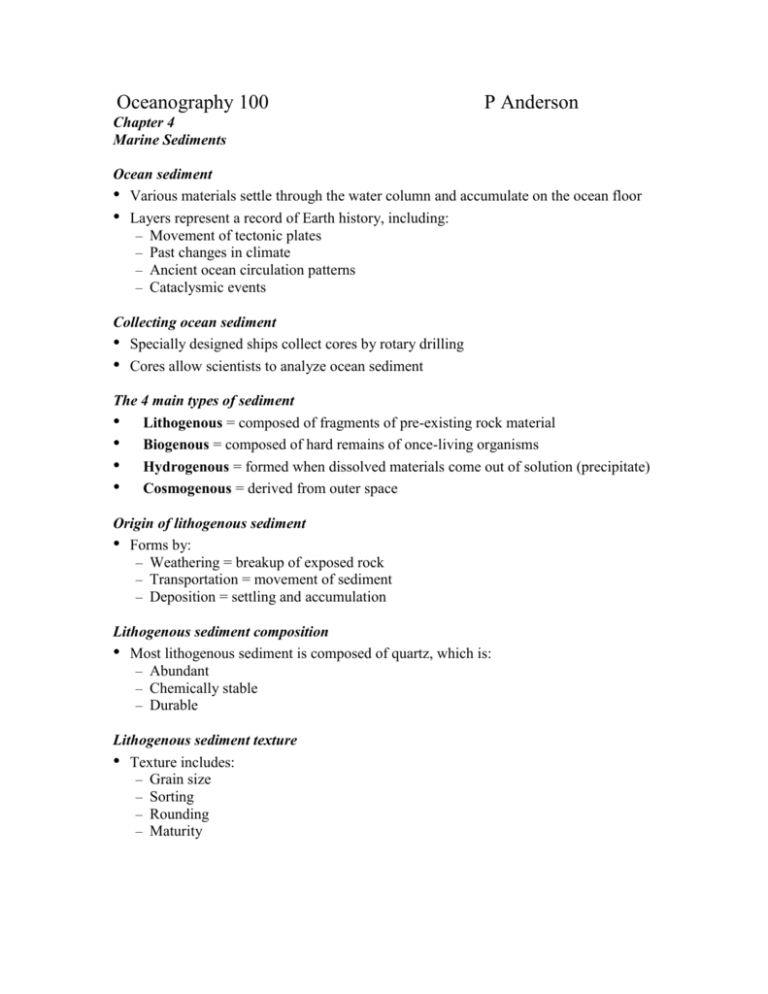
Oceanography 100 P Anderson Chapter 4 Marine Sediments Ocean sediment • Various materials settle through the water column and accumulate on the ocean floor • Layers represent a record of Earth history, including: – Movement of tectonic plates – Past changes in climate – Ancient ocean circulation patterns – Cataclysmic events Collecting ocean sediment • Specially designed ships collect cores by rotary drilling • Cores allow scientists to analyze ocean sediment The 4 main types of sediment • Lithogenous = composed of fragments of pre-existing rock material • Biogenous = composed of hard remains of once-living organisms • Hydrogenous = formed when dissolved materials come out of solution (precipitate) • Cosmogenous = derived from outer space Origin of lithogenous sediment • Forms by: – Weathering = breakup of exposed rock – Transportation = movement of sediment – Deposition = settling and accumulation Lithogenous sediment composition • Most lithogenous sediment is composed of quartz, which is: – Abundant – Chemically stable – Durable Lithogenous sediment texture • Texture includes: – Grain size – Sorting – Rounding – Maturity Distribution of lithogenous sediment • Lithogenous sediment occurs as: – Neritic (nearshore) deposits • Beaches • Continental shelves • Turbidites • Glacial-rafted debris – Pelagic (deep ocean floor) deposits • Abyssal clay Origin of biogenous sediment • Organisms that produce hard parts die • Material rains down on the ocean floor and accumulates as: – Macroscopic shells, bones, teeth – Microscopic tests (shells) • If comprised of at least 30% test material, called biogenous ooze Biogenous sediment composition • Microscopic biogenous tests are composed of 2 main chemical compounds: • Silica (SiO2) including opal (SiO2 · nH2O) • Diatoms (algae) • Radiolarians (protozoan) • Calcium carbonate or calcite (CaCO3) • Coccolithophores (algae) • Foraminifers (protozoan) Examples of silica-secreting microscopic organisms Siliceous ooze • Silica-secreting organisms accumulate to form siliceous ooze (>30% siliceous test material) Examples of calcite-secreting microscopic organisms Calcareous ooze • Calcite-secreting organisms accumulate to form calcareous ooze (>30% calcareous test material) Biogenous ooze turns to rock • When biogenous ooze hardens and lithifies, can form: – Diatomaceous earth (if composed of diatom-rich ooze) – Chalk (if composed of coccolith-rich ooze) Distribution of biogenous ooze • Most biogenous ooze found as pelagic deposits • Factors affecting the distribution of biogenous ooze: – Productivity (amount of organisms in surface waters) – Destruction (dissolving at depth) – Dilution (mixing with lithogenous clays) Distribution of siliceous ooze • Silica slowly but steadily dissolves in seawater • Siliceous ooze found where it accumulates faster than it dissolves Distribution of calcareous ooze • Calcite dissolves beneath the calcite compensation depth (CCD) at 4.5 km • Calcareous ooze can be found below the CCD if it is buried and transported to deep water Origin of hydrogenous sediment • Hydrogenous sediment forms when dissolved materials come out of solution (precipitate) • Precipitation is caused by a change in conditions including: – Changes in temperature – Changes in pressure – Addition of chemically active fluids Types of hydrogenous sediment • Manganese nodules • Phosphates • Carbonates • Metal sulfides • Evaporite salts Cosmogenous sediment • Cosmogenous sediment is composed of material derived from outer space • Two main types: • Microscopic space dust • Macroscopic meteor debris • Forms an insignificant proportion of ocean sediment Mixtures • Most ocean sediment is a mixture of sediment types • One type of sediment usually dominates, allowing it to be classified as primarily: – Lithogenous – Biogenous – Hydrogenous – Cosmogenous Worldwide distribution of neritic and pelagic sediment Ocean sediments as a resource • Ocean sediments contain many important resources, including: – Petroleum – Gas hydrates – Sand and gravel – Evaporative salts – Phosphorite – Manganese nodules and crusts
